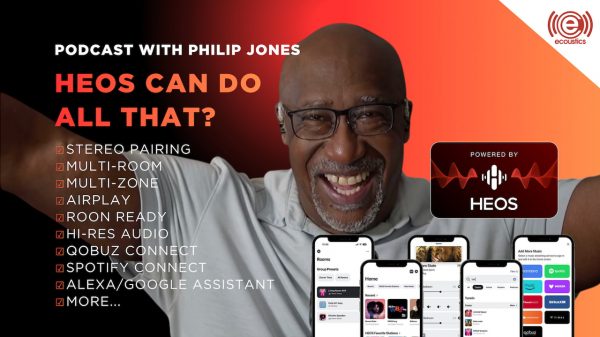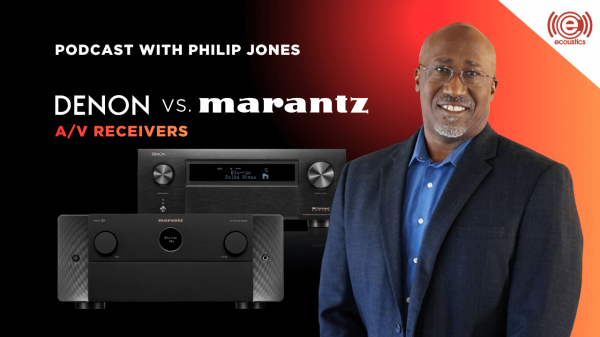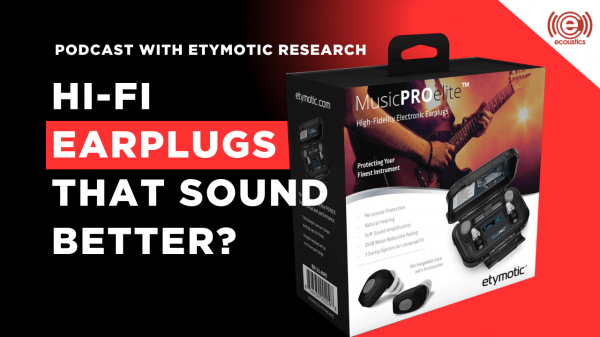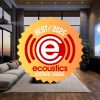Updated: June 5, 2024 – added full transcript of podcast
On May 15, 2024, Disney+ became the first mainstream streaming service to bring the IMAX Enhanced experience with DTS:X sound into your home. The first of such titles includes the “Queen Rock Montreal” concert film as well as 18 films from the Marvel Cinematic Universe.
However, all subscribers of Disney+ may not be able to experience the full impact of IMAX Enhanced with DTS:X sound unless their equipment is compatible. So we’ve invited Sven Mevissen, Director of Product Management, Home and Media Solutions, Xperi (parent company to DTS) to discuss the IMAX Enhanced program and the role that DTS:X plays in delivering immersive cinematic sound to home viewers.
Like Dolby Atmos, DTS:X immersive sound differs from traditional surround by adding a height dimension that enables sound to come from not just all around you but above you as well. The partnership between IMAX and DTS allows home viewers to experience IMAX visuals and the IMAX theatrical audio mix at home for the first time.
Sponsor: Thank you to our sponsor SVS for the support of our programming!
Where to listen:
- Apple Podcasts
- Google Podcasts
- Amazon Music
- Spotify
- iHeart Radio
- Spreaker
- Stitcher
- Deezer
- Castbox
- Podcast Addict
- Pod-chaser
- TuneIn
On the Panel:
- Brian Mitchell, Host and Founder
- Chris Boylan, Editor-at-Large
- Sven Mevissen, Director of Product Management, Home and Media Solutions at Xperi
Full Transcript of the Interview:
Brian Mitchell: Our topic is today’s very exciting launch of IMAX Enhanced with DTS:X sound on Disney+ and what that means for home theater enthusiasts. I’m delighted to welcome a very special guest Sven Mevissen – I hope I got that right – of Xperi, parent company to DTS. Welcome, Sven, and please take a moment to introduce yourself.
Sven Mevissen: Hey, Brian, Hey, Chris – very nice to be here, it’s indeed a very exciting moment for us at DTS. And I’m happy to dive into the topic. So my name is Sven Mevissen, and I’m a product manager at Xperi. Xperi is a company, you know, we have different brands some of which you might be familiar with. We have TiVo, we have DTS, we have HD Radio. I’m part of the DTS product management team, and my responsibility is the IMAX Enhanced program and ecosystem, and specifically you know around television and developing certification programs. And also, part of that responsibility is making sure that the overall DTS:X codec ecosystem, you know, remains to be a healthy ecosystem and a good experience for people at home.
Brian: Great, well thank you and also joining us is eCoustics editor at large Chris Boylan who has recently written a number of articles on DTS and immersive audio. Welcome, Chris.
Chris Boylan: Thanks. Happy to be here.
Brian: Alright, Chris. Well, we’re here to discuss the May 15th launch of IMAX Enhanced on Disney+ which is going to debut over 18 films from the Marvel Cinematic Universe and the “Queen Rock Montreal” concert. So, Sven, while we’re talking about IMAX Enhanced, I think we have to go back and talk about really what IMAX is. I think people are already familiar with the giant movie theater screens but how does that translate into bringing that experience home?
Sven: So that’s really the key premise of IMAX Enhanced. When we formed that partnership together with IMAX, the goal was really to bring that IMAX theatrical experience to people at home. IMAX obviously is known for big screens, big sound, big theaters – very high quality video and audio. And we wanted to take that sort of pinnacle of entertainment and movie-going experience and understand basically what is the formula and then translate that formula into the consumer, home domain if you will. And there are a couple of different components. One obviously is content. So IMAX content, if it’s shot on IMAX cameras, is very unique in terms of resolution, in terms of quality. There is the IMAX expanded aspect ratio.
If you’ve been to an IMAX theater you realize very quickly that the dimension of the screen is a little different, right? It’s a much taller screen than it is wide. It’s also very wide. But it’s also, you know, very tall if you compare that to a regular cinema screen, like a widescreen experience, which is much wider than it’s tall. It’s just, again, a different aspect ratio, which aligns with the aspect ratio with which IMAX movies are being shot. So again, it’s different; it’s a 1.9 by 1 aspect ratio, there are some variations around this, but you know, just generally speaking. So, again, there’s the image portion that makes this unique. And by bringing IMAX Enhanced to consumers at home it’s the first time that consumers at home are able to experience that expanded aspect ratio image component with IMAX Enhanced picture.
There’s an audio component as well. You know IMAX theaters are very well known for this big impactful sound. They achieve this with differences in how rooms are being set up, in differences of – obviously – the equipment being used. One of the main differences in an IMAX theater is that it’s all point sources. So in terms of the number of speakers you have, you have fewer numbers of speakers in the room but they are much bigger and much more powerful. They also don’t have to rely on an LFE channel in the content because they have much higher headroom, purely because of the fact that the equipment is much more capable in reproducing in all kinds of frequencies and at higher SPL.
So in a sense, an IMAX theater, from an audio perspective, is closer to what your home theater would look like, in terms of like: the three discrete speakers behind the screen, you know, in the theater. And then you have your point source speakers and your speakers above you. And what we’ve done is, again, on the image side as well as on the audio side, is again translating those unique attributes into a home environment so that it actually makes sense, right? So, for instance, we cannot assume in a home environment that you have full range speakers throughout. So we had to recreate an LFE channel for that particular way of distributing IMAX sound for home environment consumption.
And there’s a dedicated process to going from the IMAX theatrical print master, which today is a 12-track print master, and we bring this to a basically a 10 track plus LFE channel soundtrack for consumers at home. So, again, the idea is that we stay as true to the original creative intent and the original master on the image and on the audio side as possible. But we had to make some adjustments to make sure that it displays well in a consumer environment. In addition to the content component and some of the unique parts around this, is making sure that it is a consistent high quality experience and that’s where the device certification comes into play.
All theaters – all IMAX theaters – are always well maintained. There’s not a situation where you go into a theater and suddenly, you know, your left channel is missing because someone forgot to plug it in or something like that. So there’s a high quality standard on that experience as well and that’s what we’re trying to achieve with our certification program: “IMAX Enhanced.”
So, in addition to IMAX Enhanced content, we have a certification component where OEMs – device manufacturers – can opt into being certified for IMAX Enhanced, to make sure that they meet very high quality criteria, but also that there’s a consistent experience throughout the IMAX enhanced ecosystem overall.
And then there’s the third component which is playback optimization. There are dedicated IMAX modes on, let’s say, a TV to make sure that the picture has the right settings and you’re not watching your Marvel movie in “Sports” mode on your TV because that’s not necessarily what it was meant for. And the same is true on the audio side so during that conversion process of bringing the IMAX soundtrack into a format that can be distributed at home, there’s also, again, the playback component making sure that it sounds the best way possible for consumers at home. So there’s actually a lot, right, when we talk about IMAX Enhanced. Everybody’s always talking about the content, the expanded IMAX aspect ratio, but I think similarly important is the device certification and the playback optimization for consumer devices at home.
Brian: Okay, well the big change I think is Disney+ is now launching this format. Previously there was IMAX enhanced content on Disney plus prior to May 15. But can you talk about what’s different now after this new change. What has Disney done differently? What do consumers need to know and how do they know that they’re going to experience this new IMAX Enhanced with DTS:X sound?
Sven: Yeah, so about 2 and a half years ago we launched what we consider the first phase of bringing IMAX Enhanced to consumers at home on Disney plus, and that was the image component, the picture component. So, again, IMAX enhanced content stems directly from the IMAX theatrical experience and the content is being basically remastered for the home, but by keeping the same visual attributes like expanded aspect ratio. IMAX also has a dedicated remastering technology called DMR which is being used to increase fidelity of the picture and, you know, manage grain and make sure that there are no artifacts in the picture and things like that.
So we launched that about two and a half years ago on Disney plus and every time you pick one of the available IMAX Enhanced titles on Disney+, by default you are actually getting the IMAX Enhanced version. If you don’t want that, you can go in and select the widescreen version. But it will have the letterbox, you know, on top and on the bottom for most content. And with the IMAX enhanced version you, again, for selected scenes, you get expanded aspect ratio and it fills up your screen basically to almost 100%, which is a more immersive experience if you will. But from the beginning, IMAX Enhanced was always about not just image and picture quality, it was also about, you know, sound, which makes up the other 50% of the experience. So we are now very excited to be able to launch IMAX Enhanced sound, to complement the experience on Disney+ for, as you mentioned, the select number of titles from the Marvel catalog and Queen Rock Montreal, which is a very exciting title and has been one of the biggest concert films for IMAX ever.
So bringing that experience to consumers at home I think it’s really something unique and something special for people that actually really care about recreating that theatrical environment in their living rooms or in their home theaters, and things like that. So we’re very excited that we get to that second phase of the experience.
Chris: Right, and I guess my question on that would be, you have mentioned that it has been, I guess, a labor of love for many years. What was the biggest challenge in being able to bring that DTS:X and IMAX Enhanced sound component into production. Is it primarily a bandwidth issue or were there other factors at play?
Sven: You know, rolling out new technologies, especially in such a fragmented media and device environment that we are in today, takes time. So DTS:X for Streaming, which is our latest codec, is relatively new. It has been around for a number of years and there is some good level of device support. But obviously when launching new technology, you want to make sure that you can reach a relevant number of devices in market. And we’ve been building up that footprint in market over the past couple of years and getting to a point where we think there are enough devices out there so that enough people that care about the experience can opt into that experience and buy relevant equipment that’s necessary to actually get that experience.
And I know we’re going to talk about exactly what sort of components are necessary to receive IMAX Enhanced sound but again, at the end of the day, back in the DVD and Blu-ray days, life was a little simpler, right? Because you had a single standard, defining what kind of media types are allowed, what kind of codecs are supported on a DVD or on a Blu-Ray Disc. But with streaming and those sort of proprietary ecosystems that exist that streaming services built for themselves for good and valid reasons, things are just a little bit more complicated, right? They don’t all adhere to a set of specifications and standards. What Netflix does might be completely different from what Disney+ does. And that’s just the time we live in. But that also means that rolling out new technologies takes a little bit more of an effort when it comes to supporting it on the content side, supporting it on the distribution side, supporting it on the device side. And all those things need to come together in order to make this a meaningful footprint, and meaningful launch and that services like Disney Plus have the reach that they’re looking for, for their subscribers. That’s definitely a big part of it.
Bandwidth, to a certain extent, you could argue that bandwidth on a Blu-ray didn’t really matter so you could add additional audio tracks without sort of like you know paying any kind of bandwidth penalty. With streaming, obviously bandwidth still matters, right, so services are paying money for making sure that the content they’re putting out there can be consumed and the higher the bandwidth required, the more money they have to pay at the end of the day so it is a consideration. I wouldn’t call it the key consideration.
Chris: Okay, great. And I know that you referenced Blu-ray – in “the Blu-ray days” – we’re still in the Blu-ray days I guess; I mean you can still buy some UHD Blu-rays with DTS:X soundtracks. Anyway, with Blu-ray, you were delivering DTS:X a little bit differently, right? There was an existing codec, DTS-HD High Resolution Audio or DTS-HD Master Audio and those were the transport layer for the DTS:X soundtrack. Now, from what you’ve told me, now there is no separate transport layer: there’s just the DTS:X codec – “DTS:X for Streaming” – which, by the way, was that previously called DTS:X for Televisions? Was that the same codec? Because I know there’s been some reference to that as well.
Sven: Right. So, a couple of things. Let me try to unpack that. Yes, absolutely true. So from the beginning, part of the fundamental design concept for DTS was backwards compatibility.
Chris: Right.
Sven: All DTS devices in market support our core bitstream, which is the bitstream that we launched with about 25 years ago. We call this DTS Core. That’s the DTS 5.1 component. When we introduced DTS HD and as a successor, DTS:X – the original Blu-ray DTS:X I should say – the core component was always part of the bitstream. And then we added an extension on top of that to support additional use cases: use cases like immersive use cases, higher resolution use cases, completely lossless use cases and things like that. But the idea was still true that you had one bitstream that could cater to basically every single DTS device out there.
So even if you had a legacy DTS AVR from, like, 10 years ago, it would be able to decode the DTS core component in the bitstream and basically just ignore everything else around this. We changed that concept, basically fundamentally, by introducing DTS:X for Streaming.
Chris: Okay.
Sven: It was primarily because of the efficiencies required to bring high quality audio to consumers at home using the internet. So there was really no point in us adding all that additional payload to the bitstream itself to cater for all those different use cases. And we chose to basically take that burden away from the stream itself and put it on the device side.
So that’s a sort of fundamental change in the concept of how we did deliver DTS today versus how we used to deliver DTS in the days of DVD and Blu-ray.
Chris: Okay, that makes sense. So any of the new components, which right now are all televisions, will see the DTS:X for Streaming stream, then I guess with the HDMI handshake with the decoding device, be it a receiver or a soundbar, will identify what level of DTS it can support and then the source device – the TV – will transcode to the highest quality that the receiver or soundbar can accept. Is that fair to say?
Sven: That’s exactly right. Absolutely. Exactly.
Chris: So if you do have a 10 year-old DTS:X receiver, that probably would work with the new, say, Sony or Hisense TVs, because they’re seeing the DTS:X for Streaming stream and then transcoding it to something that the older devices can understand.
Sven: Exactly, that’s exactly right. Yes.
Chris: Okay.
Brian: Real quickly, to clarify, they’re transcoding it but are they essentially downgrading it from the full IMAX Enhanced to what that version of the receiver or soundbar can offer? Is that accurate?
Sven: I wouldn’t say downgrading, certainly not downgrading. So there are two components specifically, to IMAX Enhanced sound. I mentioned the playback modes and how we trigger playback modes on an IMAX Enhanced device, is by carrying basically a “content identifier” in the bitstream. So when you get content from Disney+ on an IMAX Enhanced title, we embed that content identifier in the bitstream. And that content identifier is being passed on to the downstream sync device so even if there’s transcoding happening, that content identifier is still intact once it arrives at the sync device – the destination, basically where the decoding happens. And that is also what then, again on the sync device, triggers the dedicated playback mode for IMAX enhanced equipment.
So the transcoding in itself is just making sure that, for a “DTS:X for Streaming” bitstream where, as Chris mentioned, with the HDMI/EDID handshake, the source device has identified the capability of the downstream sync device, the transcode is basically just making sure that whatever the highest capability of the downstream sync device is, that’s the stream that is being transcoded to. So, for instance, if you have a DTS:X capable receiver then it’s a simple DTS:X for Streaming to DTS:X transcode. But basically it’s a one-on-one relationship. There’s nothing else going on. There’s no down-mixing or anything going on – nothing that would degrade the signal. And if you have an older device like a DTS HD or DTS Digital Surround device then we would say, okay, this is the 10-channel DTS:X for Streaming, but your downstream sync device can only handle 5.1 so we would apply the common down-mix coefficients, that we’ve been using for years in order to recreate that experience on the downstream sync device.
Chris: Right, so even a non DTS:X soundbar, as long as it has some flavor of DTS, would get a DTS stream and it would decode let’s say the 5.1 stream and…
Sven: Exactly
Chris: …you’d still get your DTS sound and it’s still sourced from the IMAX 12 channel mix. So that’s I think what makes it different from the soundtracks that have come before it. It’s going to be the IMAX mix that was intended for IMAX theaters. It is optimized for the home theater environment and then yeah uh it’s then rendering it to the best extent that it can on the actual decoding or, as you call it, the “sync device.”
Sven: Exactly. Exactly. So, for us that’s really a key component. And we realize that a theatrical mix in a home environment is not always the right choice. So if you watch on your television late at night with like two speakers attached and your kids are sleeping next door, I would not necessarily say that you should opt into DTS:X with the full dynamic range of the theatrical mix. We do have some kind of “smart logic” and advanced loudness management, specifically for the use case where you watch on your TV and you listen on your TV, right? So we understand that TVs typically can’t deal with that dynamic range and they have other device limitations, in terms of frequency response and things like that. Okay. So we do apply some kind of loudness management so that it’s still a good experience.
But I don’t want to pretend that what we can do, in an automatic fashion, would be as good as what a creative person is doing to create those nearfield mixes for stereo playback and things like that. So it is really meant as a, you know, “theater-like” experience for people that care about that kind of experience, that have the components and the loudspeakers and the AVR or, you know, higher end sound bars at home to really sit down and have that experience without worrying too much what what your neighbors might think or, you know you know, anyone else.
Chris: Well, my neighbors already hate me so they’ll just hate me a little bit more.
Sven: (Laughs) Right, right, right. What it’s also important to point out is that – and we get these questions all the time, right? – so the theatrical mix has a different dynamic range but it also adheres to pretty much no real standard, right? The only standard is that the director in the background and the producers in the background are happy. That’s all you really care about from a creative perspective when you create those soundtracks in a theatrical environment. And yes there is, you know, certain room tunings and there are certain, you know, SPLs that are not really “required” but recommended for back in the theater.
For home that’s a little different, right? So there are certain adjustments that you make when you create your home theater or near field mix as you guys probably know: nearfield for stereo, nearfield for 5.1, nearfield for any kind of immersive flavor. So the experience when you are on Disney+ and you listen to IMAX Enhanced sound and you go back and forth is that it will sound different, right? And there is a way to do that. You can go back and forth between the home theater mix – the dedicated nearfield mix – and the theatrical experience (in the Disney+ app). It’s not going to sound drastically different but one of the most obvious things is going to be that there’s a level difference because again, when it’s in theaters, basically it’s complete creative freedom. And whatever it is in the theater is what you will get at home with that IMAX Enhanced sound version. Once you go into a nearfield environment, you reduce your dynamic range, you maybe bring in your left and rights, you change your panning a little bit and all those things. So, again there is going to be a difference.
And I hope people are not just going to judge by one being louder than the other because that’s really not what this is about. It’s really about sort of like creative intent and this puristic idea of “I get the mix that was created for theater at home” and that’s really for the first time.
Brian: But I think you’re saying that IMAX Enhanced will play louder in a home environment? Then, and I think we also have to bring it up, because people are gonna ask: Everyone’s used to Dolby Atmos or hearing about Dolby Atmos and people are going to wonder like why do I want to turn the setting on? Why do I – what am I gonna hear differently? It sounds like you’re saying it’s instantly gonna be louder and more dynamic?
Sven: No. I will say, depending on the scene you’re listening to, you’ll have more dynamic range, which really means, at the end of the day, the louder bits are louder and the quieter bits are quieter, right? That’s really what this is about. Where theatrically you say, you could argue you take a 24-bit signal and you have 144 dB of dynamic range, and that’s the range that you can operate in. That’s not the range that you operate in when you create a home theater mix, right? You bring that down and you, out of the 144 dB, maybe there are like 25 dB of dynamic range and that’s really it. So no, it’s not by default just going to be louder but the louder scenes are going to be louder and the quieter scenes are going to be quieter.
So that’s really like, when we talk about dynamic range, that’s the key difference there. But whatever the creative team that was editing and mixing the soundtrack – obviously with input from from the filmmakers – came up with and felt like “that’s how we want our movie to be represented from an acoustical perspective,” that’s what we are putting into the DTS:X codec and are delivering to consumers at home.
Chris: Makes sense. And do you actually get involved with any of the studios as they’re creating or deciding which content to bring to the IMAX Enhanced program? Or is that more of a decision between IMAX and the studios?
Sven: So that’s right, that’s mostly a conversation between IMAX and the studios. There are existing relationships, right?, because IMAX is such an important partner on the theatrical side because of really you could say their dominance in the theatrical experience – the premium theatrical experience. IMAX movies always over-index on the box office, you know. For the number of screens they have they make substantially more money than than any other screen out there.
Chris: Well they also cost a lot more.
Sven: The cost, yes that’s certainly part of it.
Chris: But they don’t necessarily cost more than a Dolby Cinema. I mean, you have that premium price that you’re used to paying for the premium experience and, what you’re saying is per screen, they’re generating a lot more income. And yes studios like that. But hopefully, with this program, if it goes well, and people are excited about it, we’ll have more than just the Marvel Cinematic Universe and a Queen concert film to choose from, let’s say maybe six months from now… maybe.
Sven: Yeah, I hope so too. And there are other content services. For instance we have a partnership with Sony Pictures and as you might know Sony has their own service called, it used to be called Bravia Core. Now it’s…
Chris: Sony Pictures Core.
Sven: Sony Pictures Core – right. They have over 150 or 200 IMAX Enhanced titles in their catalog.
Chris: Oh, I didn’t realize they had so many. Wow.
Sven: Yeah, it’s a substantial number. And Sony as a studio is a little bit different in terms of their distribution strategy. So some of that content is also available outside of Bravia Core – or Sony Pictures Core – on Rakuten TV (a streaming service), for instance, in Europe. So you can get additional IMAX Enhanced content on other services. But yes, those conversations with other streaming services are ongoing and, while I cannot really comment or speak to them, we also think that there’s going to be a lot of momentum with this launch on Wednesday – today I should say – with this launch today.
Chris: (laughs) – Yes, we’re recording this in advance, but it’s okay, people realize that. By the time it’s live, you know all of these titles should be available in Disney plus if you have the right gear.
Sven: So yes, exactly. If you have the right gear, that’s a key component.
Chris: And I will say, I did try testing this earlier. I was so excited about DTS:X and IMAX Enhanced that I had a Sony OLED for review last year and I went into BRAVIA Core (at the time) and went right to that title that was IMAX Enhanced and I played it and all I got was a standard DTS track, not DTS:X. And the reason for that was that, out of Sony’s lineup of TVs, there was really only one TV last year that could decode DTS:X directly and that was not the one that I was reviewing. It was the A95L. I had the A80L so, you know, a couple of follow-up conversations with the Sony people and they’re like “oh, yeah you need the A95L for that” and I’m like “great why didn’t you send me one of those?” So it is cool that now more TVs are going to be supporting that both in Disney+ and in Sony Pictures Core – the whole Bravia lineup for 2024, the BRAVIA 7, BRAVIA 8 and the BRAVIA 9 all decode DTS:X.
Sven: Yes, that’s correct.
Chris: So, in addition to Disney plus there’ll be a few more choices available in Sony Pictures Core as well on those Sony TVs.
Sven: Yeah, yeah and obviously Sony goes a long way back with DVD and Blu-ray, even Super Audio CD. I was a big fan of Super Audio CD back in the day, but anyway.
Chris: I still have some!
Sven: I have, you know, my favorite records are mostly on Super Audio CD – Peter Gabriel “Up” – it’s amazing. Anyway.
Chris: Roxy Music “Avalon” on SACD, It’s a wonderful recording.
Sven: Yeah, or some of the Pink Floyd stuff – “Dark Side of the Moon” in Super Audio CD is pretty amazing.
Chris: “Love it!”
Sven: Yeah, exactly. Um, I was about to say… I forgot what I was about to say. Oh yeah Sony’s PureStream technology (on Sony Pictures Core) – the bit rates that Sony is delivering with the PureStream technology are outrageous. And the quality is also amazing. It goes up to I think 80 megabits or something like that. So that’s something that’s unique to the Sony service that you can enable on your A95L and get picture quality that’s really really outstanding.
Chris: Right, right. Cool. Alright, let me see, so I think we covered a lot of the questions I had. I guess my one lingering question is that people think DTS:X is DTS:X and it’s, you know, you see that one logo you think the codec is the same everywhere. It seems like that has changed with DTS:X for Streaming. Did you consider calling it like DTS:X+ or something to differentiate it a bit from the previous versions? I mean, I know you’re calling it DTS:X for Streaming andyou’re referring to it as the “latest version” of the codec. But do you think there are going to be any people who are confused by using that name DTS:X in what’s really almost a brand new codec?
Sven: Yeah, so there was a lot of debate as you can imagine. Internally we call it P1 and P2 where we say DTS:X P1 is Profile One which is the codec used on Blu-ray and then Profile Two. And that’s a little bit, sort of yeah, I mean maybe I’m oversharing here, but I think that’s not the end of the world. P2 is Profile 2 which is our streaming codec. Yeah, fundamentally, from a technical perspective, they have nothing in common with each other. It’s completely different encoding technology on P2, DTS:X for Streaming than it is for P1, for some of the reasons that we talked about, right? DTS:X Profile 2 is a much higher efficient codec and it just didn’t make any sense for us to continue carrying a 25 year old codec within something that needs to be fit for the purposes of today’s applications.
So, yes, so we’ve been trying to consolidate the logos to actually reduce consumer confusion around this but the moment you dig into this a little bit further from a more technical perspective and for people that are interested in the technicalities of it it, I have to agree that it might get a little confusing if we call everything DTX but it’s actually two different things. And then you have a DTS:X AVR at home but it doesn’t actually know what to do with DTS:X for Streaming and things like that. So we’ve been trying to simplify this as much as possible. But yes, you can poke holes into this and then ask questions which are totally fair questions. But I do think that with this concept of the source device handling the burden of making sure that there is connectivity and compatibility to downstream sync devices, consumers ideally don’t need to care as long as they have DTS:X on the one device and DTS:X on the other device they will play back and and work together you know just as intended.
Chris: Yeah, I agree. I think you know I’ve already gotten involved in some Reddit threads and people are talking about it like “What? Why is it called the same thing?” But I think your approach is sound. Only the newer devices can support the new DTS:X for Streaming, and they take care of backward compatibility. So no matter what DTS device is is downstream – the sync device – it’ll still support DTS or DTS:X or, DTS HD Master Audio, depending on what its capabilities are. So I think it’s a great technical solution to the issue. You’re not going to get somebody trying to put a DTS:X for Streaming stream onto a legacy DTS:X device, because that source device that’s looking at that DTS:X for Streaming stream will never output that to the legacy device other than in a format that that that connected device can understand. So I don’t think there’s going to be a lot of technical problems; I think there just might be some people who are assuming that their TV which, maybe in the past was able to bitstream out a DTS signal, may not get the updated Disney+ app that allows them to take advantage of the DTS:X for Streaming and IMAX Enhanced content.
Sven: That’s a good point. In the past we had this concept of passing through a bitstream where we could do that because we knew that the core bitstream, the core DTS bitstream, can be decoded by every single DTS capable device, full stop, right? So passing something from one device to the other device at least, knowing that the end device – the sync device – has DTS capability, didn’t really present any issues or any risk. But again, that’s different with DTS:X for Streaming. So, since those sync devices don’t know what to do with this there’s always going to be um a version of transcoding which you could argue makes the integration a little bit more complicated. But again, it’s in the spirit of making sure that we have state-of-the-art technology that provides a high quality, High Fidelity experience for consumers at home.And that was the best way for us to realize that.
Chris: So I’m wondering whether you’re able to – I mean I guess you probably can do this at work – but have you been able to listen to these tracks in a home theater setting at your own home? You know, being part of the inside team?
Sven: Unfortunately not in my own home, but we’ve done demos at CES this year and we’ve done demos at NAB this year, using, you know, basically off-the-shelf components and a beta version of the Disney Plus app. And I’m still amazed even after being in the industry for 20 years that you can get that kind of experience – image and sound – over the internet to your home. So I think it’s really unique and it’s very special. And again, it’s for people that are interested in this, that like IMAX that have been to IMAX theaters, that care about audio and picture quality and have a good sounding setup at home. That for me, that’s the way to experience content. Again, not all the time. If I listen late at night, that’s a different use case – but sitting down with…
Chris: Well, late at night you’d use DTS Headphone:X actually, right?
Sven: (laughs) Right, you could do that yeah that’s true. Right Yeah, but it’s a really great experience so we’re very excited about it.
Chris: Brian, I think you had something to add?
Brian: Yeah I got a question here. So we’ve talked around all this but to really get this IMAX Enhanced DTS:X sound you need 12 speakers, right? Is that the ultimate way to get this amazing sound?
Sven: So, the consumer version is 10. So you only need 10 (laughs). it’s a 5.1.4 native experience if you will. Well… “Do you need 10 speakers?”
If you want this to be as close to the theatrical experience as possible? Yes. I, that’s just the right answer, right?
I mean, are there good sounding soundbars out there that potentially have some virtualization technology that will still give something that’s a really good experience? Yes. I think that conversation goes back all the way to the beginning of 5.1 and surround sound, right? Do I really need to have five speakers and a subwoofer in order to experience surround sound? And you know we have post-processing technology like Virtual X where we claim it’s virtualizing your speakers and things like that. But I’ve spent the first 15, almost 20, years of my professional career in post production for film and television and so I have a very puristic approach to things like that. And I would absolutely say “yes,” you need as many speakers as you have channels in order to come close to that creative intent in the experience that filmmakers and creative folks working on it intended it to be.
But there is always this consumer convenience factor, right?, where if it’s not something that you can realize at home for physical limitations or even maybe you’re not willing to spend that kind of money but you’re still interested in a good quality experience. There are solutions out there that I think are working really well. It’s not the same experience, but it still can be a really good experience. And I think that’s really, you know, up to the consumer making those choices.
And to come full circle to IMAX Enhanced, that was also part of the intent of the program, right? Just like you have the choice as a consumer when you go to the movies between an IMAX theater and a non IMAX theater. If you care, you go with the IMAX theater. It’s not a different movie. You’re gonna laugh at the same spots; you’re going to be scared at the same spots, no matter which room you choose. But if the experience and quality of the experience is part of what you care about, then you choose the IMAX version. And it’s similar with the IMAX enhanced certification program, right? If you care about picture quality, if you care about sound quality, don’t worry about all the technical jargon like HDR10 and all those things, right? Look for the IMAX enhanced logo and we promise a good experience for those devices in your environment. So that’s the idea. And that’s why we have IMAX Enhanced certified sound bars.
Chris: Right, right. I guess my follow-up question would be what about for our readers – and I’m sure there are many – who have a 7.1.4 set-up at home. Where does that get generated? Because it has to be augmented, I guess, for the surround channels, so from 5.1.4 to 7.1.4?
Sven: So, if you have an IMAX enhanced certified AVR hooked up to your 7.1.4 speaker system, we… it’s, I wouldn’t say “drastic” but I think it’s again, a very puristic approach. So, there are different ways you could recreate a 5.1.4 in a 7.1.4 setup, right? You could upmix or you can position your surrounds between your side and rear surrounds virtually and things like that. But what we do is we actually – and I realize some people might be a little bit upset about this but it was a conscious decision that we chose together with IMAX and together with the creative community – If the 5.1.4 is playing in your 7.1.4 setup, your sides are going to be silent. Because that is just it is as close to the theatrical experience as possible. If you look very closely in an IMAX theater, even your “side surrounds” are almost all the way back, right? So – okay – and that’s sort of like what we thought is the closest to that experience that you can get.
Chris: Okay. Yeah, That’s a very straightforward answer.
Sven: If you turn off your IMAX mode then the AVR is going to remap those surround speakers to likely between the side and the back surround so you will get sound coming out of all those speakers. But if you want the IMAX experience, then your sides are going to be silent in that case.
Chris: Gotcha. And I guess similar for if they have 7.1.2, then only the two height speakers will be used and the surround speakers that are not behind you – the side surround speakers – will also be deactivated if you’re in the IMAX Enhanced mode. So you’ll get a 5.1.2 render of that, correct?
Sven: Right, so you, let me think…
Chris: because the four are just height channels, right, so you would just..
Sven: So there might be some mapping going on in this case. There might be some mapping going on where we map between the front, the two heights and the backs so that you still get an accurate positional experience. We wouldn’t downmix the four heights into just two of them I think. That’s not what we would do.
Chris: Okay, yeah okay. But it’ll probably figure it out in a way that makes sense.
Sven: That’s – yes – that that’s the idea, yeah yeah.
Chris: Okay, so fortunately I’ve got 5.1.4 in my basement right now so I’m perfect.
Sven: Yeah, you’re good to go.
Brian: So we’ve talked about some hardware limitations but I want to make sure consumers are aware what they need to experience this and I think what you’re saying is you need an updated TV first and that’s going to control whether you can hear IMAX enhanced, that’s IMAX Enhanced compatible? Is that accurate?
Sven: That’s correct. So the first wave of supported products for this launch are going to be Android/Google TVs that support DTS:X. All the TVs, as Chris mentioned, all the new Sony TVs – the six, seven and eight BRAVIA series, or is it 7, 8, 9?
Chris: BRAVIA 7, 8, and 9.
Sven: Right. They support DTS:X – beautiful TVs. Hisense has a big footprint of DTS:X capable TVs running Android. Also very good TVs. In Europe, we have Philips IMAX Enhanced certified TVs with support for DTS:X. There are Sharp products. There are TCL, so again, there is no…
Chris: TCL? Sorry, so will the US TCL TVs be a part of this launch? Because I was just at an event last week…
Sven: Yes, with Android. Yeah. They’ll work as well.
Chris: Okay, I’m going to need to update my article.
Sven: So I was just about to say so there’s no restriction as long as you have a DTS:X capable TV and you’re running Android or Google TV and you’re in a region that is being serviced by Disney plus you can opt into that experience, yes.
Chris: Okay, great.
Brian: And is this a software upgrade that any manufacturer can do or is there an actual hardware piece that’s in the TV that’s making this possible?
Sven: Well, there is a simple answer to that but that’s not the reality, right? You could just update your TV “in theory,” but that’s not typically what TV OEMs do, right? Because they want to sell new products the next year.
Chris: Right.
Sven: There is a, well, yeah so that’s that’s just what it is, right? There are… there might be cases where the TV/OEM is deciding that this is an important enough feature for them that they provide this over an OTA update. But there are so many different things that go along with doing something like this right? I mean there’s some certain licensing requirements where you have to have logos on boxes and logos in manuals and all that stuff, right? That’s very difficult to realize once you have product in market. So I think it’s rather rare that you get feature updates for products already in market. So I think that that’s not very common – let’s just put it that way.
But there are, again, if you go into Best Buy or your storefront of choice, they should have DTS:X capable TVs to choose from. And we are supporting Android and Google at first but there are other platforms that will follow this year. So for instance, LG with WebOS and other Unix-based operating systems on other TV brands like Vizio Smartcast, and they will follow later this year.
Chris: Okay. And potentially platforms like Fire TV or Roku could potentially support this in the future as well with certification and potentially updates to software, maybe?
Sven: Yeah, exactly – potentially. (“Meow”)
Chris: Not sure whose cat that is – mine or yours – I’m hearing a cat in the background.
Sven: Yeah, that’s mine, I have a very noisy cat. Sorry. We also have a dog.
Chris: I was looking around for mine earlier when I first heard it. But the dog keeps quiet?
Sven: The dog is quiet all the time. The cat is like you know “I’m the boss” that’s what cats are like.
Chris: Oh, of course. I’ve, I’ve met cats, yes. I own a cat – I am, I am its slave.
Brian: Yeah, so final question for me for the consumers – and you brought up the thing about the logos – should they be looking for the IMAX enhanced logo or do they need to be looking for the DTS:X logo at the same time?
Sven: It’s a good question. We say IMAX Enhanced is an additive ecosystem so that means you don’t have to have IMAX enhanced components throughout. That’s not necessary. If you again care about the highest quality presentation, that’s our recommendation. But for this particular feature and getting this feature at home all you really need is a DTS:X capable TV. So it doesn’t have to be IMAX enhanced certified. But many of those DTS-X-capable TVs, at least you know 2023 and 2024 models, also, you know, the high-end models, have IMAX Enhanced certification.
Chris: Cool. And I guess my question would be what else would you like to add in terms of what’s coming in the future, if you can talk about it, or just general thoughts on how you think this launch is going to go.
Sven: So, again, we’ve been working on this particular launch and this feature launch for a number of years and we’re all very excited and can’t wait for people to experience this at home. In terms of what comes next, we continue our journey with IMAX in identifying other product categories, device categories, where something like this might be relevant. We have other products in the IMAX Enhanced program – you can buy HP laptops, for instance, with IMAX enhanced certification. The goal is really to set a very high standard for consumer electronic devices that meet certain high quality criteria, so it becomes easy for consumers to buy into that experience if they’re willing to.
I do think that with a lot of positive momentum we’ll hopefully see other services providing additional pieces of content in IMAX Enhanced, because it really is a differentiated experience. There’s a lot of things I can’t talk about, but right now we’re really all about celebrating this moment together with IMAX and Disney+ this week.
Brian: So final question from me is on the IMAX enhanced certification. When they get that logo, is that just that they’re compatible with IMAX Enhanced or is there some level of quality assurance that customers get when they buy those components?
Sven: So, two things: we developed certification requirements for all device categories that are IMAX Enhanced certified. If you look at the image side we have specific certification criteria for TVs. We talk about brightness, we talk about contrast ratio, we talk about panel technology, we talk about size. There is a minimum set of requirements that you have to meet in order to get IMAX Enhanced certified. And when I say minimum you know the idea is that if you buy into the certification program by choosing an IMAX Enhanced certified device, it meets high quality criteria, which is what is being defined in that specification.
That’s also true for projectors, right? We have Sony projectors in the program that are some of the best consumer projectors out there. We have soundbars, we have AVRs. In addition to making sure that they meet certain requirements around frequency response and meeting certain SPLs, they also have the dedicated playback mode. A Sony TV for instance that is IMAX enhanced certified will have a dedicated IMAX Enhanced mode to make sure that the picture is set in the best way possible for consuming and watching IMAX enhanced content. Again, this is also true for the audio component where we have dedicated IMAX Enhanced playback mode on the audio devices, for i. This takes care of things like mapping your surround channels to your rear surround in a 7.1.4, making sure that the filters are all set correctly, and including a certain level of bass management to recreate that IMAX experience at home.
We also even have mobile phones and tablets where we use some of our headphone technology to translate that experience from a big home theater onto the devices that people consume content with on a regular basis. Laptops too, as I mentioned and we’re in the process of expanding that ecosystem into other device categories as well so it’s not…
Chris: <Ding dong!> I actually have to get the door because I think my Sony TV or Soundbar just showed up. I’ll be right back.
Brian: Alright, well yeah I guess we’ll um pause here for a moment while Chris is checking the door. Any other topics that we didn’t cover yet that you wanted to make a point of.
Sven: Well we talked about devices necessary for launch to get the experience.
Chris: Ugh!
Sven: Sounds like something heavy… (laughs) I think we we covered pretty much everything, Brian so I think I’m good.
Chris: Okay. Sorry I wish that were timed better but those were actually the Sony Bravia Theatre Quad – the four speaker system that I believe is both IMAX Enhanced and DTS:X certified so perfect timing!
Sven: Is that version 2 like, which just came out this year?
Chris: Yeah the square ones.
Sven: Oh the square ones, yeah they are in fact IMAX Enhanced certified. Yes, yes, great product! I love the predecessor – they had some Wi-Fi issues but great sounding setup.
Chris: Yeah this I think, within a couple of days, the Bravia 7 TV is going to show up to go with it so I’m hoping – I’m hoping – I’m ready on uh May 15, which is today, right?
Sven: Today right today – May 15th.
Brian: May 15th! So as of today if you want the IMAX experience at home you can now get it with Disney+ and hopefully a new Sony, Hisense or TCL TV and you can experience the movie Magic at home.
And I want to thank Sven Mevissen for joining us today from Xperi, the parent company of DTS, and thank our Editor-at-Large Chris Boylan, and we hope to see everybody next time. Thanks.
Related links:


































Asa
May 20, 2024 at 4:15 pm
Have the Sony MASTER Series XBR-77A9G and Denon AVR-X6500H and only can get “Dolby Atmos” in the playback/config of the Queen concert a few nights ago (both are IMAX-E certified). I’ll have to check again, but didn’t see any further options for additional encoding/streaming types.
Is this still a work in progress? I read the Ytube comments and looks like I’m not the only one. Thanks.
Chris Boylan
June 12, 2024 at 5:16 am
Support for DTS:X sound in IMAX Enhanced on Disney+ in Sony TVs is limited to select model year 2023 TVs and above (A95L from 2023, BRAVIA 7, 8, 9 from 2024). I don’t think they’re going back any further than that. Your TV doesn’t have the DTS:X Profile 2 decoder which is required for this.
Hopefully they will port the feature to a standalone streaming box like a FireTV Stick, Roku or Android Streaming box. That way, you could still take advantage of it with your current TV and receiver.